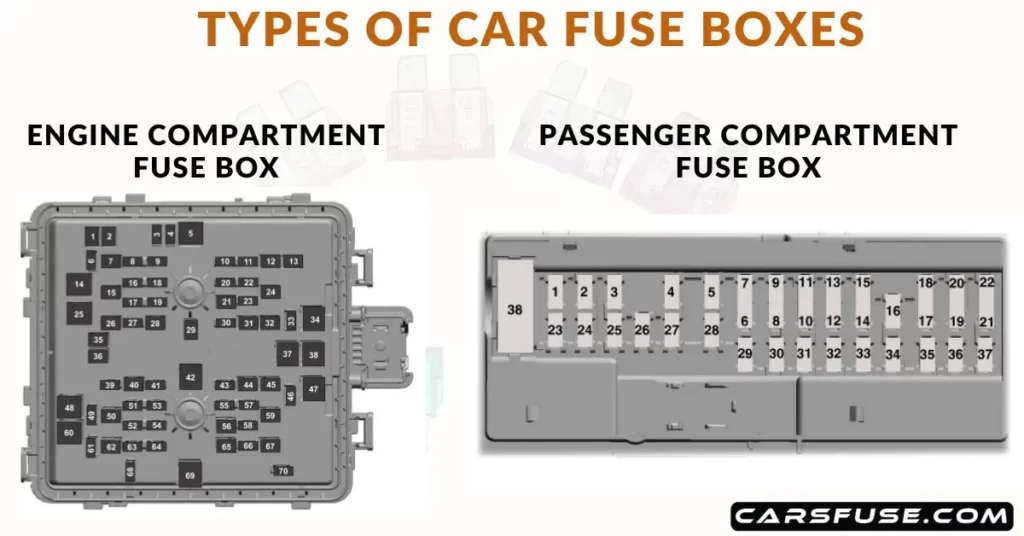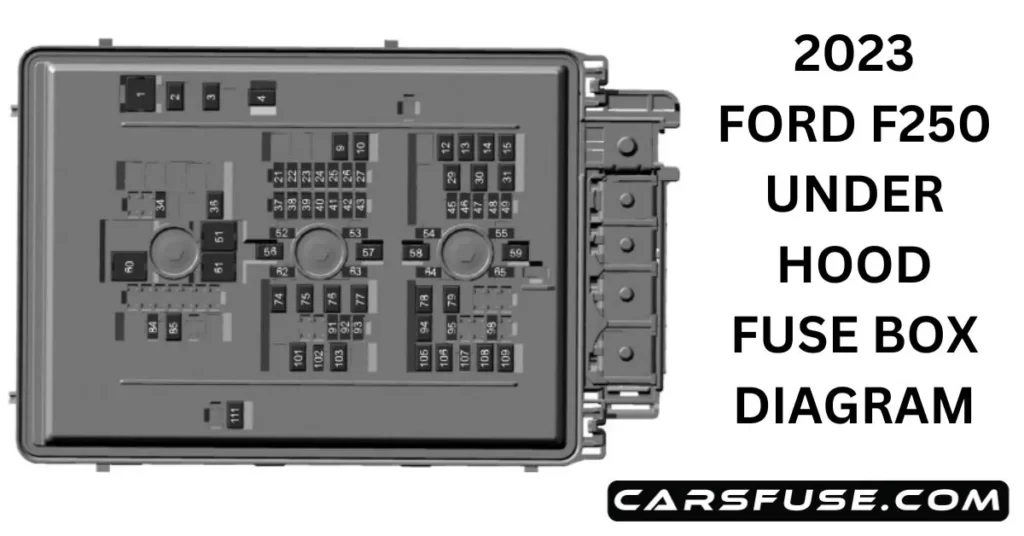Electrical systems in a vehicle are responsible for powering various components and ensuring safe driving. The term known as the fuse box plays a crucial role in protecting electrical systems from overloads, and short circuits.
In this informative article, we will explore the question, ‘How many fuse boxes does a car have?’ covering the details of fuse boxes found in vehicles along with their purposes.
Let’s get started.
Table of Contents
Are there 2 fuse boxes in a car?
The majority of vehicles are equipped with two fuse boxes: one typically known as the power distribution box, and the other as the passenger compartment fuse panel.

Other terms used for the two fuse boxes include engine compartment fuse box, and interior fuse box.
Engine Compartment Fuse Box
The engine compartment fuse box or the power distribution box is mainly located under the hood. It features high-current fuses, and is responsible for handling major electrical systems.
This fuse box contains fuse components for cooling fan, heater, trailer tow backup lamps, powertrain control module, blower motor, four-wheel drive, vehicle battery, sensor, and other important components.
To access the engine compartment fuse box, you need to open the hood of your vehicle, and locate the fuse box.
Let’s take an example of the 2023 Ford F250 Pickup truck.
The engine compartment fuse box in the 2023 Ford F250 features various fuses with specific functions as shown in the table below.

| Item | Rating | Protected Component |
| 1 | 50 A | Cooling fan 1. |
| 2 | 50 A | Heater. |
| 3 | 50 A | Heater. |
| 4 | 50 A | Heater. |
| 9 | 30 A | Four-wheel drive module. |
| 10 | 30 A | Compressed natural gas module switch. |
| 12 | 60 A | Anti-lock brake system pump. |
| 13 | 30 A | Passenger power seat. |
| 14 | 40 A | Anti-lock brake system valve. |
| 15 | 30 A | Body control module RP2 bus. |
| 21 | 10 A | Trailer tow backup lamps. |
| 22 | 10 A | Four-wheel drive system. |
| 23 | 20 A | Vehicle power 1. |
| 24 | 20 A | Vehicle power 2 (gas). |
| 10 A | Vehicle power 2 (diesel). | |
| 25 | 15 A | Vehicle power 3 (gas). |
| 10 A | Vehicle power 3 (diesel). | |
| 26 | 20 A | Vehicle power 4. |
| 27 | 10 A | Vehicle power 5 (gas). |
| 20 A | Vehicle power 5 (diesel). | |
| 29 | 15 A | Diesel exhaust fluid tank heater. |
| 30 | 15 A | Diesel exhaust fluid line heater. |
| 31 | 15 A | Glow plug and dosing module. |
| 34 | 20 A | Rear heated seats. |
| 36 | 30 A | Electronic power assists steering. |
| 37 | 5 A | 24 V alternator. |
| 38 | 10 A | Powertrain control module. Transmission control module. |
| 39 | 10 A | Anti-lock brake system. |
| 40 | 10 A | Electronic power assist steering. |
| 41 | 10 A | Blind spot information system. Trailer tow tire pressure monitoring system. Rear electronic module controller area network. |
| 42 | 10 A | Snowplow. |
| 43 | 15 A | Interior power distribution box run/start. |
| 45 | 15 A | Heated steering wheel. |
| 46 | 20 A | Not used (spare). |
| 47 | 5 A | Not used (spare). |
| 48 | 30 A | Amplifier. |
| 49 | 25 A | Not used (spare). |
| 51 | 40 A | Blower motor. |
| 52 | — | Not used. |
| 53 | 10 A | Four-wheel drive – transfer case control module. |
| 54 | 10 A | Not used (spare). |
| 55 | 10 A | Not used (spare). |
| 56 | 40 A | Electronic power assist steering. |
| 57 | 20 A | Trailer tow lighting module. |
| 58 | 50 A | Customer interface module. |
| 59 | 60 A | Inverter. |
| 60 | 60 A | Interior power distribution box B+. |
| 61 | 30 A | Vehicle battery 2. |
| 62 | 5 A | Smart trailer hitch. |
| 63 | 10 A | Smart data link connector. Enhanced central gateway. |
| 64 | 5 A | Glow plug relay coil (diesel). |
| 65 | 10 A | Compressed natural gas module power. |
| 74 | 30 A | Trailer brake control. Aftermarket e-brake access. |
| 75 | 30 A | Compressed natural gas powered at all times. |
| 76 | 25 A | Trailer tow lighting module battery charge. |
| 77 | 30 A | Vehicle battery 1. |
| 78 | 20 A | Power point 2. |
| 79 | 20 A | Power point 1. |
| 84 | 20 A | Horn. |
| 85 | 40 A | Heated rear windshield. |
| 91 | 5 A | Headlamp control module. |
| 92 | 15 A | Left-hand headlamp. |
| 93 | 15 A | Right-hand headlamp. |
| 94 | 20 A | Power point 3. |
| 95 | 20 A | Power point 4. Smart charge module. |
| 98 | 10 A | Tailgate release. |
| 101 | 50 A | Customer interface module. |
| 102 | 5 A | Rain sensor. |
| 103 | 30 A | Front wiper motor. |
| 105 | 30 A | Fuel pump. |
| 106 | 30 A | Body control module RP1 bus. |
| 107 | 25 A | Trailer tow park lamps. |
| 108 | 40 A | Driver power seat. |
| 109 | 30 A | Starter motor. |
| 111 | 30 A | Power sliding rear window. |
Passenger Compartment Fuse Panel (Interior Fuse Box)
The passenger compartment fuse panel or the interior fuse box is located in the vehicle’s dashboard or near the steering wheel.
The process of accessing the interior fuse panel depends on the vehicle model or type.
Let’s look at an example of the 2015 Ford F350 heavy-duty truck.
The passenger compartment fuse panel in the 2015 F350 is conveniently located in the footwell area on the passenger side.
You need to remove the cover of the fuse panel by gently pulling it towards you. Once you do that, the clips of the panel will disengage allowing the panel to fall smoothly.
The interior fuse box features fuses for interior lights, power windows, power mirrors, driver seat switches, turn signals, brake lamps, headlamps, amplifiers, subwoofers, ignition switches, and so on.
The passenger compartment fuse panel of the 2015 F350 is illustrated in the table below.

| Fuse or relay number | Fuse amp rating | Protected components |
| 1 | 30A | Not used (spare) |
| 2 | 15A | Auxiliary switch relay #4 |
| 3 | 30A | Passenger smart window motor |
| 4 | 10A | Hood lamp Interior lights |
| 5 | 20A | Moonroof |
| 6 | 5A | Driver seat module |
| 7 | 7.5A | Driver lumbar motor Driver seat switch |
| 8 | 10A | Power mirror switch |
| 9 | 10A | Auxiliary switch relay #3 |
| 10 | 10A | Customer access feed Run/accessory relay |
| 11 | 10A | Instrument cluster |
| 12 | 15A | Interior lighting Lighted running board lamps |
| 13 | 15A | Right turn signals and brake lamps |
| 14 | 15A | Left turn signals and brake lamps |
| 15 | 15A | Backup lamps, Trailer tow backup relay High-mounted stop lamps Reverse signal interior mirror |
| 16 | 10A | Right low beam headlamp |
| 17 | 10A | Left low beam headlamp |
| 18 | 10A | Brake shift interlock Keypad illumination Passive anti-theft transceiver Powertrain control module |
| 19 | 20A | Amplifier Subwoofer |
| 20 | 20A | Power door locks |
| 21 | 10A | Brake on/off switch |
| 22 | 20A | Horn |
| 23 | 15A | Not used (spare) |
| 24 | 15A | Diagnostic connector Electronic finish panel Power fold mirror relay Remote keyless entry Steering wheel control module |
| 25 | 15A | Not used (spare) |
| 26 | 5A | Steering wheel control module |
| 27 | 20A | Not used (spare) |
| 28 | 15A | Ignition switch |
| 29 | 20A | GPS module Radio SYNC |
| 30 | 15A | Parking lamp relay Trailer tow parking lamp relay |
| 31 | 5A | Customer access Trailer brake controller (brake signal) |
| 32 | 15A | Auto dimming mirror Driver and passenger door lock switch illumination Driver and passenger smart window motor Moonroof motor Passenger window switch Power inverter Rear heated seat switch illumination Telescoping mirror switch |
| 33 | 10A | Restraint control module |
| 34 | 10A | Heated steering wheel module Rear heated seats module |
| 35 | 5A | Reverse park aid module Select shift switch Trailer brake control module |
| 36 | 10A | Fuel tank select switch |
| 37 | 10A | Positive temperature coefficient heater |
| 38 | 10A | AM/FM base radio |
| 39 | 15A | High beam headlamps |
| 40 | 10A | Parking lamps (in mirrors) Roof marker lamps |
| 41 | 7.5A | Passenger airbag deactivation indicator |
| 42 | 5A | Not used (spare) |
| 43 | 10A | Wiper relay |
| 44 | 10A | Auxiliary switches |
| 45 | 5A | Not used (spare) |
| 46 | 10A | Climate control |
| 47 | 15A | Fog lamps Fog lamp indicator (in switch) |
| 48 | 30A Circuit breaker | Power rear sliding window switch Power windows switch Moonroof switch |
| 49 | Relay | Delayed accessory |
Basically, there are two fuse boxes in a vehicle: one for the high-current fuses, and the other for the cabin component fuses.
The location of the fuse boxes varies depending on the vehicle model, and type. However, the basic understanding is the same. The engine compartment fuse box is located under the hood while the interior fuse box is located near the driver seat.
Conclusion on ‘How many fuse boxes does a car have?’
As we come to the end of this blog, we explored two common types of fuse boxes in a vehicle including the engine compartment fuse box (power distribution box), and the interior fuse box (passenger compartment fuse panel).
We also looked at a power distribution box of the Ford F250, and the passenger compartment fuse panel of the Ford F350 pickup truck to have a clear understanding of two fuse boxes in a car.
By familiarizing yourself with the fuse box setup/fuse box diagram in your car and following the recommended maintenance practices, you can proactively address electrical issues, prevent potential breakdowns, and ultimately prolong the lifespan of your vehicle.

